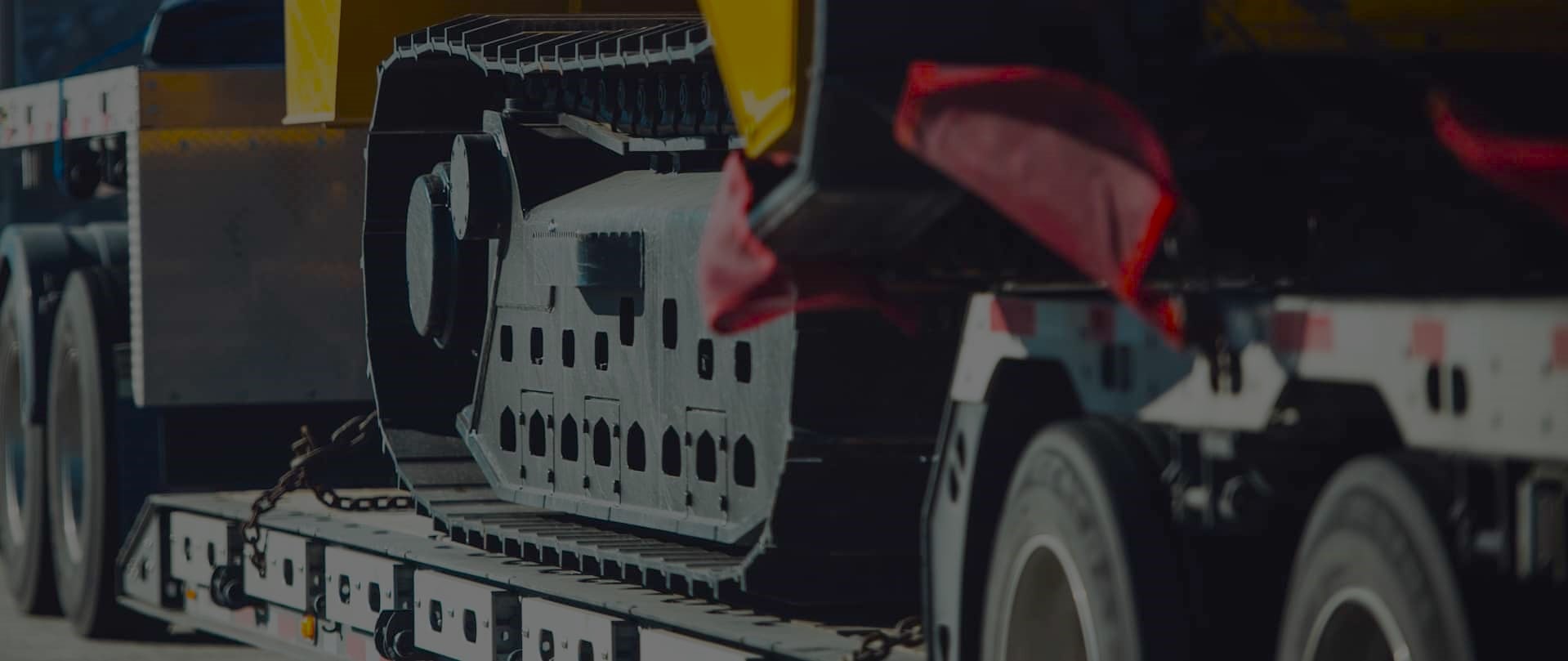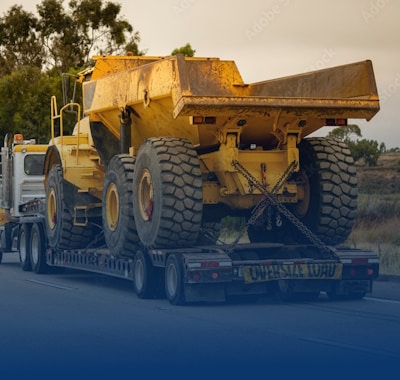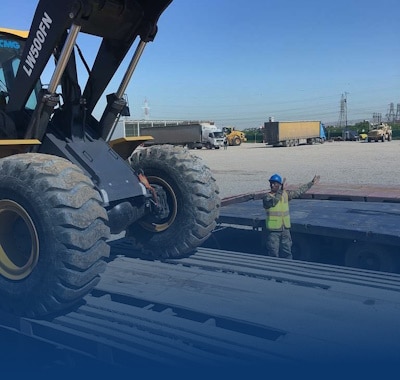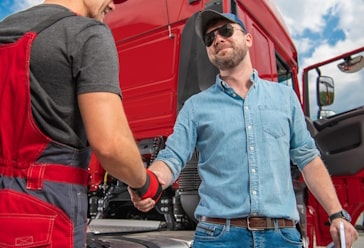Essential Permits for Hauling Well Drilling Rigs
Freedom Heavy Haul can offer expedited Pickup and Delivery for any size shipment anywhere in the USA. Contact us today for No Hassle, No Pressure Pricing.
When you move well drilling rigs, you must follow the law closely. Permits for heavy haul trucking keep everyone safe and protect roads. Without them, you could face delays, fines, or even stop work.
Getting permits involves federal, state, and local rules. Each one has its own rules for weight, routes, and safety. Knowing these rules helps avoid big mistakes in oil and gas projects.
This guide makes getting permits for well drilling rigs easier. It talks about important rules, planning, and tips for safe heavy haul trucking. Stay ahead by focusing on following the rules and being well-prepared.
Understanding the Basics of Well Drilling Rig Transportation
Transporting well drilling rig equipment needs careful planning and following trucking rules. These big rigs often need special permits because of their size. Even small mistakes can cause delays or fines. Here are the key things to remember.
Common Challenges in Rig Movement
When moving rig equipment, you face tight turns, low bridges, and uneven ground. Trucking rules change by state, so permits must match local laws. Bad weather, like heavy rain or ice, increases the risk of accidents, mainly with big loads. If route checks aren’t done early, delays can happen.
Key Components Requiring Special Attention
Some parts of the rig need extra care when moving:
- Mast and substructure: Can get damaged by vibrations.
- Drill pipe racks: Need to be strapped down well to avoid shifting.
- Hydraulic systems: Are sensitive to temperature changes.
Securing these parts right helps follow trucking rules and cuts down on wear.
Weight and Size Considerations
Because rig equipment is often too big for regular roads, you need oversized load permits. For example, a drilling rig can weigh over 80,000 pounds and be 14 feet wide. Permits outline the exact route, if you need escort vehicles, and when you can travel.
Always check axle weight to avoid fines for road damage.
Planning for these details helps avoid risks and keeps projects on track.
Legal Framework for Heavy Equipment Transportation
When moving well drilling rigs, following laws is key. The Federal Motor Carrier Safety Administration (FMCSA) has rules for moving heavy equipment. These include weight limits and who can drive.
Rigs over 80,000 pounds need special permits. Teams must check axle weights to prevent road damage.
“Safety is non-negotiable. Carriers must ensure equipment is secured, routes are surveyed, and drivers are trained to handle oversized loads.”
— FMCSA Oversight Division
Rules for drilling site access vary by state. In Texas, rigs wider than 14 feet need a Single Trip Permit. North Dakota requires escorts for loads over 12 feet. Local areas might have their own rules, like no heavy hauling during school hours.
Working with experienced logistics providers helps deal with these rules.
- Verify federal permits for gross vehicle weight and hazardous materials.
- Coordinate with state agencies for route-specific approvals.
- Check county regulations for drilling site access roads and environmental impact rules.
Breaking the law can cost up to $10,000 per violation and delay projects. In 2022, a Texas operator was fined for ignoring bridge weight limits. Good planning, like using GPS and surveying routes, helps avoid legal trouble. This ensures drilling rigs are moved safely and on time, protecting roads and communities.
Well Drilling Rigs: Permits for Heavy Haul Trucking
Getting well drilling rigs to their destination is a complex process. Heavy haul trucking needs permits at the federal, state, and local levels. This ensures safety and avoids delays.
Federal Permit Requirements
The Federal Highway Administration (FHWA) handles permits for interstate moves. You must provide details like axle weight, vehicle size, and route. For loads over 12 feet wide or 80,000 pounds, a Super Load permit is needed.
The FHWA aims to review applications in 15 business days. But, they suggest applying early for complex routes.
State-Specific Regulations
States like Texas and Alaska have their own rules for road permits. Texas requires escorts for loads over 14 feet wide. Alaska has seasonal restrictions due to icy roads.
Fees for permits vary. California charges $60 for single-trip permits. Ohio uses a mileage-based system. Always check for seasonal changes or temporary closures.
Local Municipality Guidelines
Counties and cities have their own rules. Houston requires nighttime travel for rigs over 16 feet tall. This helps avoid traffic problems.
In rural areas, bridge weight limits might change routes. Local permits usually take 3–5 days. But, expedited services are available for urgent needs. Always check for construction zones or special event restrictions.
“Permitting isn’t just paperwork—it’s a safety blueprint. Missing one local guideline can stall a project for weeks.” – FHWA Oversight Report, 2023
Operators should keep a checklist. This includes federal approvals, state road permits, and local clearances. Digital tools like the FMCSA Permit System can help. But, human oversight is key.
Regular updates from state DOT websites can prevent surprises.
Route Planning and Road Access Requirements
Planning routes for well drilling rigs is key to success. Getting road permits is just the start. You also need to think about physical barriers and local rules.
Bridge Weight Restrictions
Bridges in rural areas have strict weight limits. Always check these limits with state agencies like the Texas Department of Transportation. If rigs are too heavy, you could face fines or damage.
Pro tip: Send axle weight details early to get permits faster.
Height Clearance Considerations
Things like power lines and tunnels can stop you. Use tools like Google Earth Pro to check clearances. For example, in Louisiana, rigs must be under 14 feet to avoid low-hanging lines.
Always check with local authorities to avoid having to change your route.
“Route planning isn’t just about maps. It’s a safety-first collaboration between drivers, engineers, and communities.” – American Trucking Associations
Alternative Route Planning
Have a plan B for when roads are closed or too narrow. Use software like Rand McNally’s Motor Carrier Atlas to find good routes. Talk to county officials about seasonal road issues.
Key steps include:
- Assessing traffic patterns during peak hours
- Identifying rest stops for oversized loads
- Reviewing weather forecasts for detour viability
Using real-time data helps reduce risks. Combining technology with good communication ensures smooth operations.
Safety Equipment and Documentation Requirements
When moving rig equipment, following safety rules and trucking laws is key. Making sure vehicles are well-equipped and keeping accurate records helps avoid risks. Here are the main things to focus on:
- Warning devices: Reflective triangles, LED flares, and rotating amber lights must be visible to other drivers, for oversized loads.
- Secure tie-downs: Chains, binders, and straps rated for the rig equipment’s weight prevent shifting during transit.
- Permits and licenses: Carry physical or digital copies of state-specific permits, oversize load authorizations, and driver credentials.
OSHA requires regular checks of hauling vehicles and rig equipment before leaving. Use checklists for brake, tire, and hydraulic system checks. Safe transport practices also include checking load distribution and securing movable parts like drill booms.
“A single oversight in documentation or equipment checks can lead to fines, delays, or accidents. Preparation is non-negotiable.”
Drivers must keep logs of communication, incident reports, and maintenance records for at least three years. States like Texas and California have extra rules, like needing escort vehicles for wide loads.
| Equipment | Standard | Inspection Frequency |
|---|---|---|
| Warning Signs | FMCSA §392.22 | Pre-trip |
| Tie-Down Systems | ANSI/ASME B30.9 | Daily |
| Brake Systems | OSHA 1926.601 | Weekly |
Operators should check federal and state trucking laws every year. Working with insurers and legal advisors helps keep records up to date. Training drivers and crew regularly stresses the need for these rules.
Seasonal and Time-Based Permit Restrictions
When moving well drilling rigs, it’s important to follow seasonal and time-based rules. These rules help keep everyone safe, avoid delays, and protect the roads. It’s key to plan ahead to make sure transportation runs smoothly.
Weather-Related Considerations
Weather like snow, rain, or thawing can make roads slippery. Alabama, for example, has rules to keep roads safe during winter. Permits might have special weather rules, asking carriers to stop when it’s too bad outside.
Alabama’s rules are clear about when big trucks can’t go. They’re strict during wet weather. Always check the weather forecast and your permit before you move.
Peak Traffic Hours
In cities, big trucks can’t move during rush hours to avoid traffic jams. These times usually are:
- Weekdays: 6:30–9:00 AM and 3:30–6:30 PM
- School zones: Avoid 7:00–8:30 AM and 2:00–4:00 PM
Permits might list when you can travel. Moving during off-peak hours helps you follow the rules and keeps things running smoothly.
Holiday Transportation Rules
Holidays mean no heavy hauling for many states. This includes big days like Thanksgiving, Christmas, and July 4th. Some places even stop issuing permits during these times.
“Carriers must review holiday schedules six weeks in advance to avoid fines,”
the Federal Highway Administration warns. Talk to local agencies to make sure you have the right permits and plan your move for another time.
Planning ahead for weather and busy times helps keep projects on schedule. Following permit rules helps avoid problems and keeps everyone safe.
Insurance and Liability Coverage for Rig Transport
Transporting rig equipment needs more than just skilled drivers and strong trucks. It also requires good insurance. Accidents or damages can cause big delays and costs. The right insurance protects against these losses and follows trucking rules.
Federal law says carriers must have a minimum of liability insurance. The Federal Motor Carrier Safety Administration (FMCSA) sets the rules:
- $750,000–$5 million liability coverage, depending on cargo type
- Cargo insurance to cover rig equipment during transit
- Physical damage insurance for the transport vehicle
“Underestimating coverage limits is a common mistake. A single incident involving oversized loads can exceed basic policies, leaving companies vulnerable.” – National Association of Heavy Haul Carriers
State rules can add more to what’s needed. For example, Texas needs extra endorsements for oversized loads. California has strict rules for environmental liability. Always check local rules before moving rig equipment.
Look at your insurance policies closely. Some might not cover things like “acts of nature” or “mechanical failures.” Working with insurers who know heavy haul trucking helps. Regular checks on coverage and updates on rules keep things safe and smooth.
Escort Vehicle Requirements and Regulations
When moving well drilling rigs, following escort vehicle rules is key. These rules help keep everyone safe, avoid delays, and meet road permit requirements. Planning well reduces risks and keeps things running smoothly.
Types of Escort Vehicles Needed
States have specific rules for escort vehicles based on the rig’s size. Here are some common setups:
- Pilot cars: They have flashing lights, flags, and height poles. Ford F-150 or Chevy Silverado are often used.
- Rear escorts: They watch the traffic behind the rig. RAM 2500 is a common choice for this role.
- Additional escorts: Needed for wide loads over 16 feet. In places like Texas or Alberta, state patrol cars might be used.
Escort Driver Qualifications
Drivers need special training and licenses. Here’s what’s required:
- They must complete courses like Smith System Driver Safety or National Safety Council programs.
- They should know the local road permit rules, including seasonal ones.
- They need to work well with rig operators and local authorities.
Communication Protocols
Keeping in touch in real-time is vital to avoid accidents and keep things moving. Teams use:
| Device | Purpose | Examples |
|---|---|---|
| Two-way radios | Immediate updates on road conditions | Motorola CLS1410, Kenwood TK-7360 |
| GPS trackers | Route monitoring for drilling site access | Garmin dezl OTR700, Trimble TDC100 |
| Checklists | Pre-trip inspections | FMCSA compliance forms |
Escort teams must record their talks with traffic control and share updates with logistics managers. This keeps things in line with permits and avoids fines.
Emergency Response Planning and Protocols
Transporting rig equipment needs careful emergency planning. Heavy haul trucking faces risks like equipment shifts and weather issues. The Federal Motor Carrier Safety Administration (FMCSA) requires detailed response plans for accidents and disasters.
These plans help follow trucking rules and keep crews safe. They also protect the equipment and the road.
“A well-structured emergency plan reduces downtime and liability. It’s not just paperwork – it’s a roadmap for saving lives when seconds count.”
Good emergency plans have three main parts:
- Real-time communication systems linking drivers, escort vehicles, and dispatch centers
- Pre-identified response teams for mechanical failures or road incidents
- Weather monitoring tools integrated with route optimization software
Carriers must do drills every quarter. They practice for things like brake failures or load shifts. Texas DOT says this practice can cut incident severity by 37%.
Documentation kits should be ready in 15 seconds. They include hazardous material sheets, permit copies, and emergency contacts.
New tech helps in emergency responses. GPS and dashcams can alert authorities and show what happened. Working with local emergency services makes responses faster.
Review plans every year. Update them with new trucking rules and changes in the area.
Cost Analysis of Permit Acquisition
Planning expenses for permits and road permits is key. Teams must consider both direct costs and hidden fees to stay within budget. Knowing these costs helps keep operations smooth and avoids delays.
Application Fees
Agencies set fees for permits. For example, oversized load permits through the FMCSA cost $60. Texas charges up to $150 for special permits. Local areas might add fees based on route complexity or infrastructure impact.
Additional Service Charges
There are extra costs to consider:
- Route surveys ($500–$2,000) to check clearance and road conditions
- Escort vehicles ($75–$150 per hour per vehicle)
- Expedited processing fees (up to 200% of standard permit costs)
“Smart budgeting starts with anticipating variables like seasonal route changes or last-minute adjustments. Always allocate 15–20% extra for unexpected costs.” – Transportation Manager, RigMove Solutions
Budget Planning Tips
- Start permit applications 6–8 weeks before transport dates to avoid rush fees
- Use digital tools like PermitZilla or HaulHub to track fee structures across states
- Partner with permit service companies for volume discounts on recurring road permits
Teams that plan costs early reduce financial risks. Using real-time data and contingency funds helps in heavy haul budgeting.
Digital Permit Systems and Online Applications
The heavy haul trucking industry is moving to digital permit systems. This change makes it easier to move rig equipment. States like Texas and California now offer online applications, available 24/7.
Key benefits of digital permit systems include:
- Faster processing: Applications reviewed in hours instead of days.
- Cost savings: Lower administrative fees compared to manual submissions.
- Error reduction: Automated checks ensure compliance with trucking regulations.
“Digital permits cut approval times by 60% for oversized loads. It’s a game-changer for rig transporters.” – FMCSA Representative
To apply online, follow these steps:
- Create an account on your state’s transportation portal.
- Upload rig equipment details, including weight and dimensions.
- Pay fees electronically and receive permits via email.
| Platform | Key Features | Coverage |
|---|---|---|
| FMCSA Portal | Real-time status updates, multi-state permits | National |
| Texas DOT | Route-specific permits, instant fee calculator | Statewide |
| California DOA | Mobile-friendly interface, holiday restrictions alerts | Statewide |
Always check if permits meet local trucking rules. Digital systems alert you to issues like expired insurance. For oversized rigs, some states need extra documents, which you can upload online.
Using digital solutions makes heavy haul trucking smoother. With quick updates and easy records, companies spend less time on paperwork. They can focus more on safe, timely deliveries.
Navigating the Future of Heavy Haul Transportation Permits
The way we move well drilling rigs is always changing. Places like Texas and California are moving to digital permit systems. This means operators can get permits in minutes, not days.
Tools like Trimble’s GPS tracking help rigs stay on the right path. This keeps them safe and on schedule.
The FMCSA is always updating rules for big loads. Keeping up with these changes is key. Resources like state DOT newsletters and OSHA webinars help with this.
Using software to plan routes is also important. It helps avoid problems like low bridges or road closures. Training drivers for complex routes is another must.
New tech like AI could change how we get permits. Working together with agencies can speed up the process. Tools like the Texas DOT’s online portal help businesses stay quick and flexible.
Being open to new technology is key. It helps companies stay ahead in the heavy haul trucking world.







